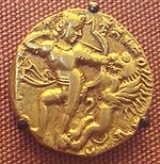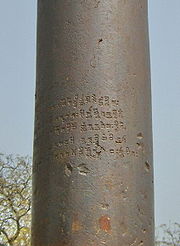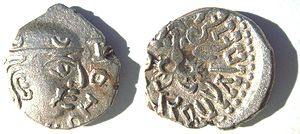
Kumara Gupta I
Encyclopedia
Kumaragupta I was a ruler of the Gupta Empire
in 415–455 CE
. Like his father and predecessor, Chandragupta II
, Kumaragupta was an able ruler. He retained, intact, the vast empire, which extended from Bengal
to Kathiawar
and from the Himalayas
to the Narmada
. He ruled efficiently for nearly forty years. However, the last days of his reign were not good. The Gupta Empire was threatened by the rebellion of Pushyamitras of central India and invasion of the White Huns. However, Kumaragupta was successful in defeating both threats and performed Ashvamedha
(horse sacrifice) to celebrate his victory. He issued new coins with images of Lord Kartikeya
.
Bhukti. A prince, Ghatotkachaqupta was the governor of Eran
and a third governor (or feudatory), Bandhuvarma was the ruler of Dashapura
. The Karmadande inscription (436 CE) mentions Prithivishena, who was initially mantrin and kumaramatya (minister) of Kumaragupta I, but later became his mahabaladhikrita (general).
 Kumaragupta erected an iron pillar, today visible at the Qutb complex
Kumaragupta erected an iron pillar, today visible at the Qutb complex
. The iron pillar is one of the world's foremost metallurgical curiosities. The pillar was originally located in the temple
of Muttra, with the deity Garuda
at the top. It is the only piece of the Hindu
temple remaining, which stood there before being destroyed by Qutb-ud-din Aybak
to build the Qutub Minar and Quwwat-ul-Islam mosque. Qutub built around it when he constructed the mosque.
Made up of 98% wrought iron
of impure quality, it is 23 feet, 8 inches high and has a diameter of 16 inches. The pillar is a testament to the high level of skill achieved by ancient Indian iron smiths in the extraction and processing of iron. It has attracted the attention of archaeologists
and metallurgists
as it has withstood corrosion
for the last 1600 years, despite harsh weather.
 The modern scholars are divided in opinion regarding the immediate successor of Kumaragupta I. While some scholars opine that he was succeeded by his son Skandagupta, other scholars contend that he was succeeded by his other son, Purugupta. Some scholars even think that both Skandagupta and Purugupta are the same person.
The modern scholars are divided in opinion regarding the immediate successor of Kumaragupta I. While some scholars opine that he was succeeded by his son Skandagupta, other scholars contend that he was succeeded by his other son, Purugupta. Some scholars even think that both Skandagupta and Purugupta are the same person.
The Junagadh rock inscription of Skandagupta mentions:
The full significance of this passage is obscure. It is, however, certain that the superior ability and prowess of Skandagupta in a time of crisis led to his choice as ruler in preference to other possible claimants after the death of Kumara Gupta I and proud of his successes against the barbarians, Skandagupta assumed the title of Vikramaditya.
The continuous attacks of the Huns weakened the Gupta empire. Skandagupta died in 467 CE. After his death, the Gupta empire began to decline.
from Mathura in the reign of Kumaragupta has been dated to 432 CE, and a pedestal (with no king's name on it - but presumably from Kumaragupta's reign - has been dated to 442 CE.
The Bilsad inscription is the oldest record of his reign and it dates to Gupta year 96, which corresponds to 415 CE.
The last known date of his reign occurs on an inscription on one of his silver coins, corresponding to 445 CE.
Gupta Empire
The Gupta Empire was an ancient Indian empire which existed approximately from 320 to 550 CE and covered much of the Indian Subcontinent. Founded by Maharaja Sri-Gupta, the dynasty was the model of a classical civilization. The peace and prosperity created under leadership of Guptas enabled the...
in 415–455 CE
Common Era
Common Era ,abbreviated as CE, is an alternative designation for the calendar era originally introduced by Dionysius Exiguus in the 6th century, traditionally identified with Anno Domini .Dates before the year 1 CE are indicated by the usage of BCE, short for Before the Common Era Common Era...
. Like his father and predecessor, Chandragupta II
Chandragupta II
Chandragupta II the Great, very often referred to as Vikramaditya or Chandragupta Vikramaditya in Sanskrit; was one of the most powerful emperors of the Gupta empire in northern India. His rule spanned c...
, Kumaragupta was an able ruler. He retained, intact, the vast empire, which extended from Bengal
Bengal
Bengal is a historical and geographical region in the northeast region of the Indian Subcontinent at the apex of the Bay of Bengal. Today, it is mainly divided between the sovereign land of People's Republic of Bangladesh and the Indian state of West Bengal, although some regions of the previous...
to Kathiawar
Kathiawar
Kathiawar or Kathiawad is a peninsula in western India, which is part of the Saurashtra region on the Arabian Sea coast of Gujarat state. It is bounded on the north by the great wetland of the Rann of Kutch, on the northwest by the Gulf of Kutch, on the west and south by the Arabian Sea, and on...
and from the Himalayas
Himalayas
The Himalaya Range or Himalaya Mountains Sanskrit: Devanagari: हिमालय, literally "abode of snow"), usually called the Himalayas or Himalaya for short, is a mountain range in Asia, separating the Indian subcontinent from the Tibetan Plateau...
to the Narmada
Narmada River
The Narmada , also called Rewa is a river in central India and the fifth largest river in the Indian subcontinent. It is the third largest river that completely flows within India after Ganges and Godavari...
. He ruled efficiently for nearly forty years. However, the last days of his reign were not good. The Gupta Empire was threatened by the rebellion of Pushyamitras of central India and invasion of the White Huns. However, Kumaragupta was successful in defeating both threats and performed Ashvamedha
Ashvamedha
The Ashvamedha was one of the most important royal rituals of Vedic religion, described in detail in the Yajurveda...
(horse sacrifice) to celebrate his victory. He issued new coins with images of Lord Kartikeya
Murugan
Murugan also called Kartikeya, Skanda and Subrahmanya, is a popular Hindu deity especially among Tamil Hindus, worshipped primarily in areas with Tamil influences, especially South India, Singapore, Sri Lanka, Malaysia, Mauritius and Reunion Island. His six most important shrines in India are the...
.
Administrative set-up
During his reign, Chiratadatta was the governor of PundravardhanaPundravardhana
This article is about the historical territory. For the Mahabharata kingdom see Pundra KingdomPundravardhana , was a territory located in North Bengal in ancient times, home of the Pundra, a group of people speaking languages not of the Indo-European family.-Etymology:There are several theories...
Bhukti. A prince, Ghatotkachaqupta was the governor of Eran
Eran
Eran is an ancient Indian historical city in Sagar district in Madhya Pradesh state. It can be called to be the oldest historical town of Sagar district in Madhya Pradesh. In earlier coins and inscriptions its name appears as Airikiṇa . From an early inscription at Sanchi we know that the...
and a third governor (or feudatory), Bandhuvarma was the ruler of Dashapura
Mandsaur
Mandsaur or Mandsour is a city in the Malwa region and district of Madhya Pradesh state of central India. It is the administrative headquarters of Mandsaur District.-Origin of name:...
. The Karmadande inscription (436 CE) mentions Prithivishena, who was initially mantrin and kumaramatya (minister) of Kumaragupta I, but later became his mahabaladhikrita (general).
Iron pillar

Qutb complex
The Qutb complex , also spelled Qutab or Qutub, is an array of monuments and buildings at Mehrauli in Delhi, India. The construction of Qutb Minar was intended as a Victory Tower, to celebrate the victory of Mohammed Ghori over Rajput king, Prithviraj Chauhan, in 1192 AD, by his then viceroy,...
. The iron pillar is one of the world's foremost metallurgical curiosities. The pillar was originally located in the temple
Temple
A temple is a structure reserved for religious or spiritual activities, such as prayer and sacrifice, or analogous rites. A templum constituted a sacred precinct as defined by a priest, or augur. It has the same root as the word "template," a plan in preparation of the building that was marked out...
of Muttra, with the deity Garuda
Garuda
The Garuda is a large mythical bird or bird-like creature that appears in both Hindu and Buddhist mythology.From an Indian perspective, Garuda is the Hindu name for the constellation Aquila and...
at the top. It is the only piece of the Hindu
Hindu
Hindu refers to an identity associated with the philosophical, religious and cultural systems that are indigenous to the Indian subcontinent. As used in the Constitution of India, the word "Hindu" is also attributed to all persons professing any Indian religion...
temple remaining, which stood there before being destroyed by Qutb-ud-din Aybak
Qutb-ud-din Aybak
Qutb-ud-din Aibak was a Turkic king of Northwest India who ruled from his capital in Delhi where he built the Qutub Minar and the Quwwat Al Islam mosque. He was of Turkic descent from central Asia, the first Sultan of Delhi and founder of the Slave dynasty of India. He ruled for only four years,...
to build the Qutub Minar and Quwwat-ul-Islam mosque. Qutub built around it when he constructed the mosque.
Made up of 98% wrought iron
Wrought iron
thumb|The [[Eiffel tower]] is constructed from [[puddle iron]], a form of wrought ironWrought iron is an iron alloy with a very low carbon...
of impure quality, it is 23 feet, 8 inches high and has a diameter of 16 inches. The pillar is a testament to the high level of skill achieved by ancient Indian iron smiths in the extraction and processing of iron. It has attracted the attention of archaeologists
Archaeology
Archaeology, or archeology , is the study of human society, primarily through the recovery and analysis of the material culture and environmental data that they have left behind, which includes artifacts, architecture, biofacts and cultural landscapes...
and metallurgists
Metallurgy
Metallurgy is a domain of materials science that studies the physical and chemical behavior of metallic elements, their intermetallic compounds, and their mixtures, which are called alloys. It is also the technology of metals: the way in which science is applied to their practical use...
as it has withstood corrosion
Corrosion
Corrosion is the disintegration of an engineered material into its constituent atoms due to chemical reactions with its surroundings. In the most common use of the word, this means electrochemical oxidation of metals in reaction with an oxidant such as oxygen...
for the last 1600 years, despite harsh weather.
Succession after Kumaragupta I

The Junagadh rock inscription of Skandagupta mentions:
…whom the goddess of fortune and splendour of her own accord selected as her husband, having in succession (and) with judgment skillfully taken into consideration and thought over all the causes of virtues and faults, (and) having discarded all (the other) sons of kings (as not coming up to her standard).
The full significance of this passage is obscure. It is, however, certain that the superior ability and prowess of Skandagupta in a time of crisis led to his choice as ruler in preference to other possible claimants after the death of Kumara Gupta I and proud of his successes against the barbarians, Skandagupta assumed the title of Vikramaditya.
The continuous attacks of the Huns weakened the Gupta empire. Skandagupta died in 467 CE. After his death, the Gupta empire began to decline.
Dated inscriptions
An inscription on a figure of a yakshaYaksha
Yaksha is the name of a broad class of nature-spirits, usually benevolent, who are caretakers of the natural treasures hidden in the earth and tree roots. They appear in Hindu, Jain and Buddhist mythology. The feminine form of the word is ' or Yakshini .In Hindu, Jain, and Buddhist mythology,...
from Mathura in the reign of Kumaragupta has been dated to 432 CE, and a pedestal (with no king's name on it - but presumably from Kumaragupta's reign - has been dated to 442 CE.
The Bilsad inscription is the oldest record of his reign and it dates to Gupta year 96, which corresponds to 415 CE.
Decline of the Gupta Empire
Inscriptions prove that the Gupta sovereignty was acknowledged in the Jabbalpur region in the Narmada valley as late as AD 528, and in North Bengal till AD 543–544. Kumaragupta II is believed to have been ruling in AD 473–474, Buddhagupta from AD 476–495, Vainyagupta in AD 508 and Bhanugupta in AD 510–511. The Gupta empire became to disintegrate and till the middle of the sixth century AD, they had merely became petty chiefs.The last known date of his reign occurs on an inscription on one of his silver coins, corresponding to 445 CE.

